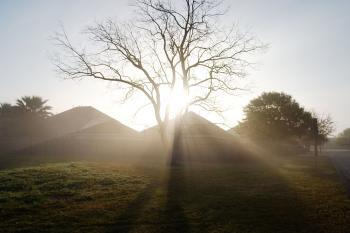Teenagers who receive insufficient exposure to morning light tend to sleep later at night and do worse on standardized tests, according to the first field study of its kind.
“As teenagers spend more time indoors, they miss out on essential morning light needed to stimulate the body’s 24-hour biological system, which regulates the sleep/wake cycle,” reported Dr. Mariana Figueiro, assistant professor and program director at Rensselaer Polytechnic Institute’s Lighting Research Center (LRC) and lead researcher on the new study, in a press release.
“These morning-light-deprived teenagers are going to bed later, getting less sleep, and possibly under-performing on standardized tests. We are starting to call this the teenage night owl syndrome.”
In the study recently published in Neuroendocrinology Letters, Figueiro and LRC Director Dr. Mark Rea discovered that 11 eighth-grade students who put on special glasses to stop short-wavelength (blue) morning light from reaching their eyes experienced a half-an-hour delay in sleep altogether after five days.
“If you remove blue light in the morning, it delays the onset of melatonin, the hormone that indicates to the body when it’s nighttime,” said Figueiro. “Our study shows melatonin onset was delayed by about 6 minutes each day the teens were restricted from blue light. Sleep onset typically occurs about 2 hours after melatonin onset.”
The researchers pointed out that today’s schools have tight schedules requiring teenagers to be in school quite early in the morning. They easily miss the morning light as they usually arrive at school before or during sunrise.
In addition, the schools most likely provide insufficient electric light or daylight to replenish the lack of morning sunlight, according to Figueiro. She said that in addition to sleep patterns, lack of morning light can also affect body temperature, alertness, appetite, and hormones.
“According to our study, however, the situation in schools can be changed rapidly by the conscious delivery of daylight, which is saturated with short-wavelength, or blue, light,” said Figueiro, adding that her study findings should have significant implication for school design.
To read the research paper, click here
“As teenagers spend more time indoors, they miss out on essential morning light needed to stimulate the body’s 24-hour biological system, which regulates the sleep/wake cycle,” reported Dr. Mariana Figueiro, assistant professor and program director at Rensselaer Polytechnic Institute’s Lighting Research Center (LRC) and lead researcher on the new study, in a press release.
“These morning-light-deprived teenagers are going to bed later, getting less sleep, and possibly under-performing on standardized tests. We are starting to call this the teenage night owl syndrome.”
In the study recently published in Neuroendocrinology Letters, Figueiro and LRC Director Dr. Mark Rea discovered that 11 eighth-grade students who put on special glasses to stop short-wavelength (blue) morning light from reaching their eyes experienced a half-an-hour delay in sleep altogether after five days.
“If you remove blue light in the morning, it delays the onset of melatonin, the hormone that indicates to the body when it’s nighttime,” said Figueiro. “Our study shows melatonin onset was delayed by about 6 minutes each day the teens were restricted from blue light. Sleep onset typically occurs about 2 hours after melatonin onset.”
The researchers pointed out that today’s schools have tight schedules requiring teenagers to be in school quite early in the morning. They easily miss the morning light as they usually arrive at school before or during sunrise.
In addition, the schools most likely provide insufficient electric light or daylight to replenish the lack of morning sunlight, according to Figueiro. She said that in addition to sleep patterns, lack of morning light can also affect body temperature, alertness, appetite, and hormones.
“According to our study, however, the situation in schools can be changed rapidly by the conscious delivery of daylight, which is saturated with short-wavelength, or blue, light,” said Figueiro, adding that her study findings should have significant implication for school design.
To read the research paper, click here







Friends Read Free